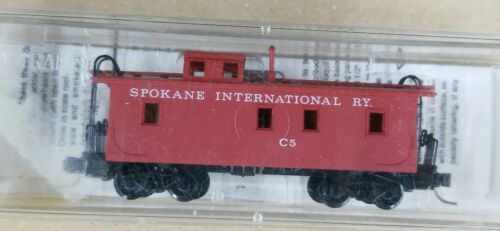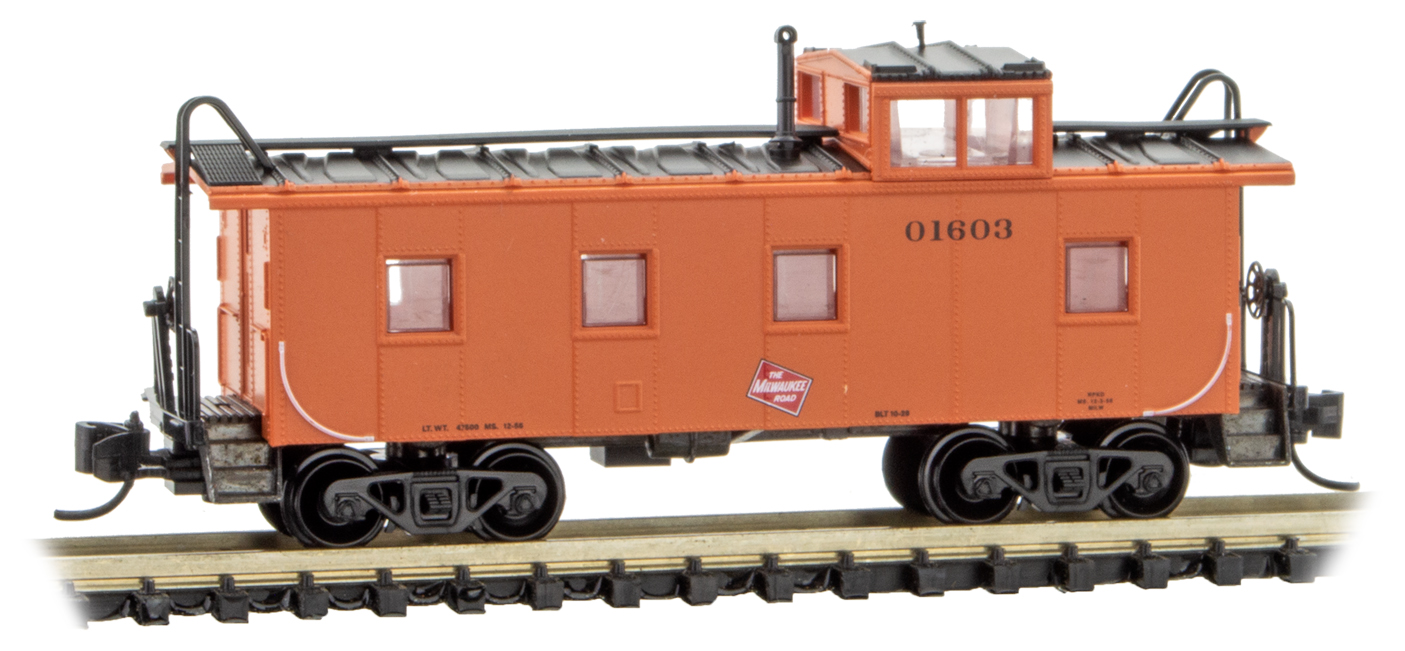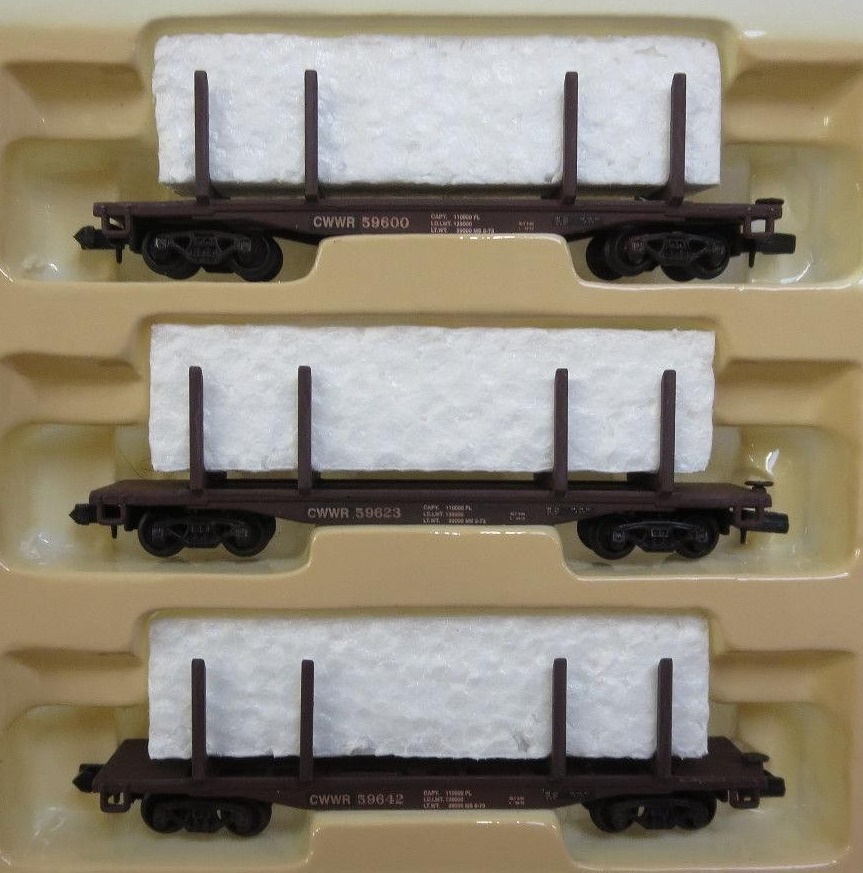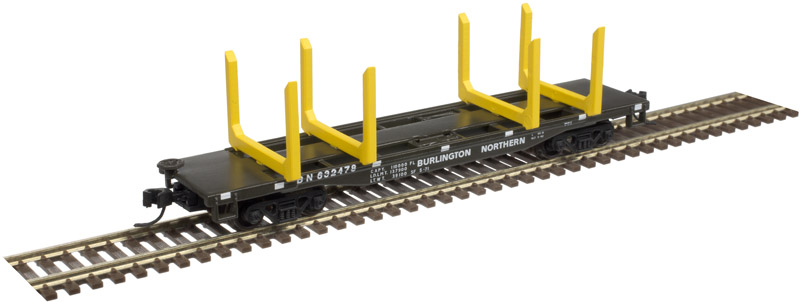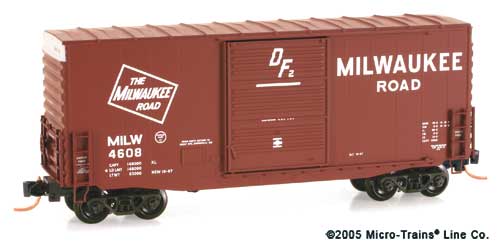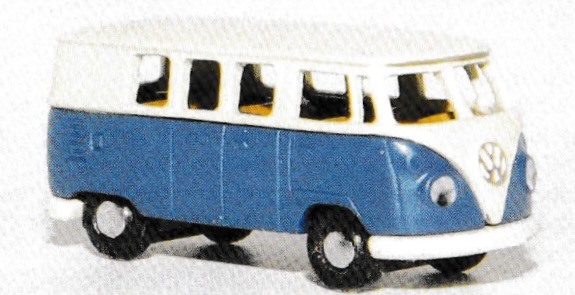Model Information: This body style is one of MTL's oldest caboose designs and dates back to June of 1975 when they introduced both a painted/unlettered version as well as a UP paint scheme. Early versions of this car come without simulated glass in their windows, much the same as Atlas' older caboose designs did. More recent versions have simulated glass. The model is of a wood-sided caboose with a cupola towards one end (offset) that was common in the 1st half of the 20th century. The model also has a roofwalk. Micro-trains has produced this car in about 20 different road names since its introduction (as of 2017) and it has also been quite popular for special runs.
At first glance it can be hard to tell the difference between this model (50000 series) and its sister-model the 'straight-side' cupola (51000 series). The difference lies primarily in the cupola (there might be other differences but I cannot see them). If you examine the car from one end (doesn't matter which), you will see that the sides of the cupola (not the car) slant at an angle from the roof of the cupola down to the roof of the car. Furthermore, the window configuration of the ends of the cupola is quite different with the 50000 series having three windows per end, while the 51000 series has only two.
At first glance it can be hard to tell the difference between this model (50000 series) and its sister-model the 'straight-side' cupola (51000 series). The difference lies primarily in the cupola (there might be other differences but I cannot see them). If you examine the car from one end (doesn't matter which), you will see that the sides of the cupola (not the car) slant at an angle from the roof of the cupola down to the roof of the car. Furthermore, the window configuration of the ends of the cupola is quite different with the 50000 series having three windows per end, while the 51000 series has only two.
Prototype History: The origins of the railroad caboose appear to date back to the 1840s when Nat Williams, a conductor of the Auburn & Syracuse Railroad (a later affiliate of the New York Central) became fed up with cramped and uncomfortable quarters to do paperwork (a common job of the conductor, whose responsibility is general oversight and control of a train, passenger or freight), which was usually done in either a free space of a passenger car or combine/baggage car. To fix this problem, Williams found an unused boxcar and using a simple box and barrel, as a seat and desk, set up shop in the car to do his duties. Not only did he find out he had plenty of room to work but also figured that he could use the unused space to store tools (flags, lanterns, spare parts, etc.) and other essentials to have on board whenever needed (such things become commonly stored on the caboose).
Perhaps the most striking feature ever applied to the railroad caboose was its cupola. According to the story, conductor T.B. Watson of the Chicago & North Western in the 1860s reportedly used a hole in a boxcar’s roof (which he was using as a caboose) to get a better vantage point of the train ahead. It is said that Watson was amazed by the view afforded from the position being able to not only see the train ahead but also from all sides, and to the rear as well. He apparently convinced C&NW shop forces to construct a type of open observation box onto an existing singe-level caboose with windows all around where one could sit and view their surroundings. The rest, as they say, is history and the common cupola was born.
Perhaps the most striking feature ever applied to the railroad caboose was its cupola. According to the story, conductor T.B. Watson of the Chicago & North Western in the 1860s reportedly used a hole in a boxcar’s roof (which he was using as a caboose) to get a better vantage point of the train ahead. It is said that Watson was amazed by the view afforded from the position being able to not only see the train ahead but also from all sides, and to the rear as well. He apparently convinced C&NW shop forces to construct a type of open observation box onto an existing singe-level caboose with windows all around where one could sit and view their surroundings. The rest, as they say, is history and the common cupola was born.
Road Name History: 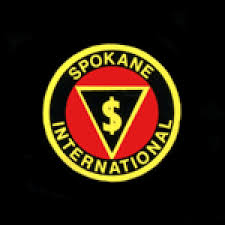 The Spokane International Railroad (reporting mark SI) was a short line railroad between Spokane, Washington, and the Canadian Pacific Railway (CP) at Kingsgate, British Columbia. The line became an important one for the CP with its connections to the Union Pacific Railroad and Portland, Oregon.
The Spokane International Railroad (reporting mark SI) was a short line railroad between Spokane, Washington, and the Canadian Pacific Railway (CP) at Kingsgate, British Columbia. The line became an important one for the CP with its connections to the Union Pacific Railroad and Portland, Oregon.
The line, originally named the Spokane International Railway, was built by local businessman and railroader Daniel Chase Corbin following an agreement between him and the CP, with CP agreeing to fund much of the line's construction and to secure the loan by holding the new line's bonds.
Especially significant was that the CP controlled the Minneapolis, St. Paul and Sault Ste. Marie Railway (Soo Line) and its connections to Minneapolis, Minnesota, Saint Paul, Minnesota, and Chicago, Illinois. Completion of the Spokane International now meant that the CP could compete with the Northern Pacific Railway and Great Northern Railway lines for transportation between the Midwest and the Puget Sound area (in conjunction with the Union Pacific Railroad subsidiary Oregon-Washington Railroad and Navigation Company west of Spokane). Express passenger service was soon introduced on the line via the Soo-Spokane Train De Luxe.
The SI was reorganized October 1, 1941, following financial difficulties and receivership during the Great Depression. The line was renamed the Spokane International Railroad as part of the restructuring agreement until the 1950s.
On October 6, 1958, the Union Pacific Railroad (UP) took control of Spokane International Railroad. In 1962 UP leased SI's 11 ALCO RS-1 locomotives for operation. The locomotives were later repainted to UP's yellow and gray paint scheme, but retained their SI lettering. Also in 1962, UP sold four of its older steel cabooses to SI. These were also painted in UP's yellow scheme, but received SI lettering and numbers. After UP's 1958 control of SI, Union Pacific continued to lease SI for operation. On December 31, 1987, Union Pacific formally merged SI into its corporate structure.
At the end of 1960 SI operated 150 miles of road on 190 miles of track; that year it reported 141 million net ton-miles of revenue freight and zero passengers.
The line remains in operation as an important UP connection between southern British Columbia and the northwest United States.

The line, originally named the Spokane International Railway, was built by local businessman and railroader Daniel Chase Corbin following an agreement between him and the CP, with CP agreeing to fund much of the line's construction and to secure the loan by holding the new line's bonds.
Especially significant was that the CP controlled the Minneapolis, St. Paul and Sault Ste. Marie Railway (Soo Line) and its connections to Minneapolis, Minnesota, Saint Paul, Minnesota, and Chicago, Illinois. Completion of the Spokane International now meant that the CP could compete with the Northern Pacific Railway and Great Northern Railway lines for transportation between the Midwest and the Puget Sound area (in conjunction with the Union Pacific Railroad subsidiary Oregon-Washington Railroad and Navigation Company west of Spokane). Express passenger service was soon introduced on the line via the Soo-Spokane Train De Luxe.
The SI was reorganized October 1, 1941, following financial difficulties and receivership during the Great Depression. The line was renamed the Spokane International Railroad as part of the restructuring agreement until the 1950s.
On October 6, 1958, the Union Pacific Railroad (UP) took control of Spokane International Railroad. In 1962 UP leased SI's 11 ALCO RS-1 locomotives for operation. The locomotives were later repainted to UP's yellow and gray paint scheme, but retained their SI lettering. Also in 1962, UP sold four of its older steel cabooses to SI. These were also painted in UP's yellow scheme, but received SI lettering and numbers. After UP's 1958 control of SI, Union Pacific continued to lease SI for operation. On December 31, 1987, Union Pacific formally merged SI into its corporate structure.
At the end of 1960 SI operated 150 miles of road on 190 miles of track; that year it reported 141 million net ton-miles of revenue freight and zero passengers.
The line remains in operation as an important UP connection between southern British Columbia and the northwest United States.
Brand/Importer Information: Micro-Trains is the brand name used by both Kadee Quality Products and Micro-Trains Line. For a history of the relationship between the brand and the two companies, please consult our Micro-Trains Collector's Guide.
Manufacturer Information:  Kadee Quality Products originally got involved in N-Scale by producing a scaled-down version of their successful HO Magne-Matic knuckle coupler system. This coupler was superior to the ubiquitous 'Rapido' style coupler due to two primary factors: superior realistic appearance and the ability to automatically uncouple when stopped over a magnet embedded in a section of track. The success of these couplers in N-Scale quickly translated to the production of trucks, wheels and in 1972 a release of ready-to-run box cars.
Kadee Quality Products originally got involved in N-Scale by producing a scaled-down version of their successful HO Magne-Matic knuckle coupler system. This coupler was superior to the ubiquitous 'Rapido' style coupler due to two primary factors: superior realistic appearance and the ability to automatically uncouple when stopped over a magnet embedded in a section of track. The success of these couplers in N-Scale quickly translated to the production of trucks, wheels and in 1972 a release of ready-to-run box cars.
In October 1990 Kadee separated in two companies, with the newly created Micro-Trains® Line Co. continuing the Z, Nn3, and N Scale product ranges, with Kadee retaining the HO range.

In October 1990 Kadee separated in two companies, with the newly created Micro-Trains® Line Co. continuing the Z, Nn3, and N Scale product ranges, with Kadee retaining the HO range.
Item created by: nscalemodeler160 on 2016-04-10 18:41:53. Last edited by gdm on 2021-05-22 00:51:41
If you see errors or missing data in this entry, please feel free to log in and edit it. Anyone with a Gmail account can log in instantly.
If you see errors or missing data in this entry, please feel free to log in and edit it. Anyone with a Gmail account can log in instantly.


